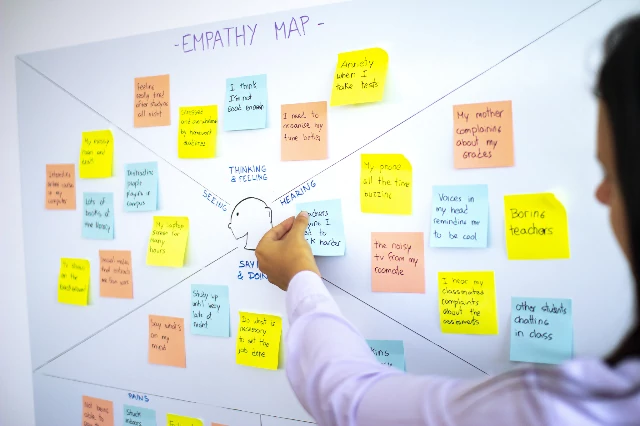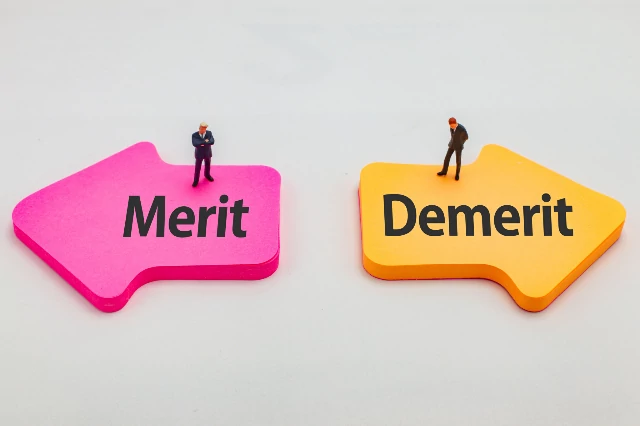With the diversification of work styles and values, consumer needs and various services are undergoing rapid changes. As a result, new ways of thinking are being sought in the business arena, and “design thinking” is attracting particular attention. Design thinking considers things from the user’s point of view and responds to their essential concerns and needs. In this article, I will explain an overview of design thinking, useful frameworks, and challenges in implementing it.
Table of Contents
ToggleWhat is design thinking?
Design thinking is a way of thinking that leads to solutions to problems and issues by utilizing the way of thinking and methods that designers use when creating “designs”. The word “design” here has a strong connotation of “design” rather than “decoration”. Here’s an overview of design thinking and why it’s getting so much attention.
process
Regarding the design thinking process, Professor Hasso Platner of Harvard University proposes “5 stages of design thinking”. Details of the five processes are below.
1. Empathy
First, observe and empathize with the user. Specifically, we explore the needs of users by grasping the issues that users feel about services and products. It’s important to know the real feelings from the user’s point of view, instead of just accepting the user’s opinion.
2. Definition
Next, derive what the user really wants. Many users do not inherently understand their own needs, so we need to explore underlying needs that go deeper than the user’s perceived needs.
3. Conceptualization
Next, we will consider the method of approach to solve the defined problem. It is important to generate as many ideas as possible using as many people as possible. Categorize many ideas into specific ideas that get the most support.
4. Prototype
After that, we will give shape to the conceptualized idea. We visualize new issues through the production of prototypes, enabling us to visualize more specific ideas. It is necessary to be careful not to spend too much time and money on the prototype because it is made only to explore the issues.
5. Test
Finally, after creating a prototype and conducting internal reviews, ask users how they feel about using the product. Then, based on user feedback, we check whether the defined issues match the essential needs. Based on the test results, we improve the product and aim for the final solution.
Read Also: Web Designers Need To Know! What Is Internet Grammar?
Background required in the business scene
This kind of design thinking process is becoming more and more important in today’s business scene, mainly for the following two reasons.
The first background is “DX conversion”, that is, an effort to make our lives better with digital technology. Today, DX is being promoted worldwide, and companies are under pressure to find answers to unprecedented problems while discovering user needs. As mentioned above, design thinking is characterized by discovering the essence of issues from the user’s point of view, so it is also useful in promoting DX.

It is also important from the perspective of realizing “service design”. Service design is a methodology that creates new value by designing not only the user experience but also the organization and structure that can continuously provide that experience. Similar to design thinking, it is a methodology from the user’s point of view, and many companies are currently paying attention to create products that are chosen by users by differentiating them from competing products in the market.
Impact on business
What are the benefits of applying design thinking to your business?
First of all, we can build an internal environment where it is easy to generate new ideas through design thinking. By going through the five stages of the design thinking process mentioned above, we will create an environment where new realizations and ideas can be generated while repeating the verification of hypotheses and the PDCA cycle.
It is also expected that the organization itself will be strengthened. By incorporating design thinking, it is possible to build a relationship of trust between team members because they can share recognition and direction in the process of exchanging opinions among team members. Not only can design thinking improve the quality of products and services, but it can also strengthen the organization as a whole by strengthening ties between members.
design thinking framework
When implementing design thinking, it is effective to use existing frameworks. Using a framework makes it easier to visualize ideas and share them within the team. Use it effectively to increase your productivity. Here are three main frameworks that help with design thinking.
Empathy Map
Empathy Map is a framework that organizes users’ thoughts and actions from six perspectives. We aim to better understand our users by applying different needs to the following six types.

- See (what you see)
- Hear (what you hear)
- Think (what you think and feel)
- Do (what you say and do)
- Pain (pain and stress)
- Gain (what you want )
By using the empathy map, you can clarify what the personas set by your company feel and think in real life, and it is useful for analyzing the user’s way of thinking and values.
Business environment map
The business environment map is a framework for digging deep into the business model, and is basically used together with the “SWOT analysis”. Both the business environment map and the SWOT analysis analyze the target from various perspectives, but by performing the two analyzes at the same time, it is possible to perform a more accurate analysis.
Business environment map
/market
/industry
/trend
/macro analysis
- SWOT Analysis
- Strength
- Weakness
- Opportunity
- Threat
business model canvas
The business model canvas is a framework for analyzing each element of a business model by dividing it into the following nine types. By organizing and overlooking all the elements, you can concisely summarize the direction of the entire business and products. It can be said that it is a useful method for obtaining hints for issues and new ideas that you have not noticed.
- Customer Segments
- Customer Relationships
- Channels
- Value Propositions
- Key Activities
- Key Resources
- Key Partners
- Cost Structure
- Revenue Streams
Design thinking challenges
The design thinking processes and frameworks introduced so far can be a great help to your business if you handle them well, but there are challenges in introducing and using them. While keeping in mind the following points to keep in mind, let’s fully enjoy the benefits by preparing the necessary skills and environment to properly introduce design thinking.

can be a mundane question
Design thinking is a method of exploring concerns, needs, and potential problems from the user’s point of view. In order to make design thinking a meaningful approach, it is essential to have a broad perspective and a high level of imagination that can stand from the perspective of users who have different ideas.
If design thinking is adopted for the time being while skills are lacking, it will be difficult to draw meaningful conclusions because the problem setting will be mundane. Therefore, when incorporating design thinking, it is important to simultaneously develop and recruit human resources who have the skills to think flexibly in response to questions such as “What is the problem?” and “How can we solve it?” .
Difficult to understand benefits
Another problem is that it is difficult to obtain sufficient internal understanding of the necessity and merits of design thinking. In the first place, the majority of employees belonging to companies are in occupations that are not related to design. For this reason, there are many cases in which the mere mention of the term “design thinking” makes one feel that it has nothing to do with them.
In this way, it will be difficult to ask for an understanding of the merits and needs if you do not get interested at the starting point. Of course, it is difficult to put design thinking into practice in a company that does not have an advanced understanding of design thinking, and the execution of ideas that have been conceived will not proceed smoothly. As a result, the experience value of design thinking will not be accumulated, so it is necessary to emphasize the promotion of internal understanding of the merits.
Summary
In this article, I explained an overview of design thinking, useful frameworks, and challenges in implementing it. Creative thinking that tackles problem solving from the user’s point of view is an essential approach to business in the future.

